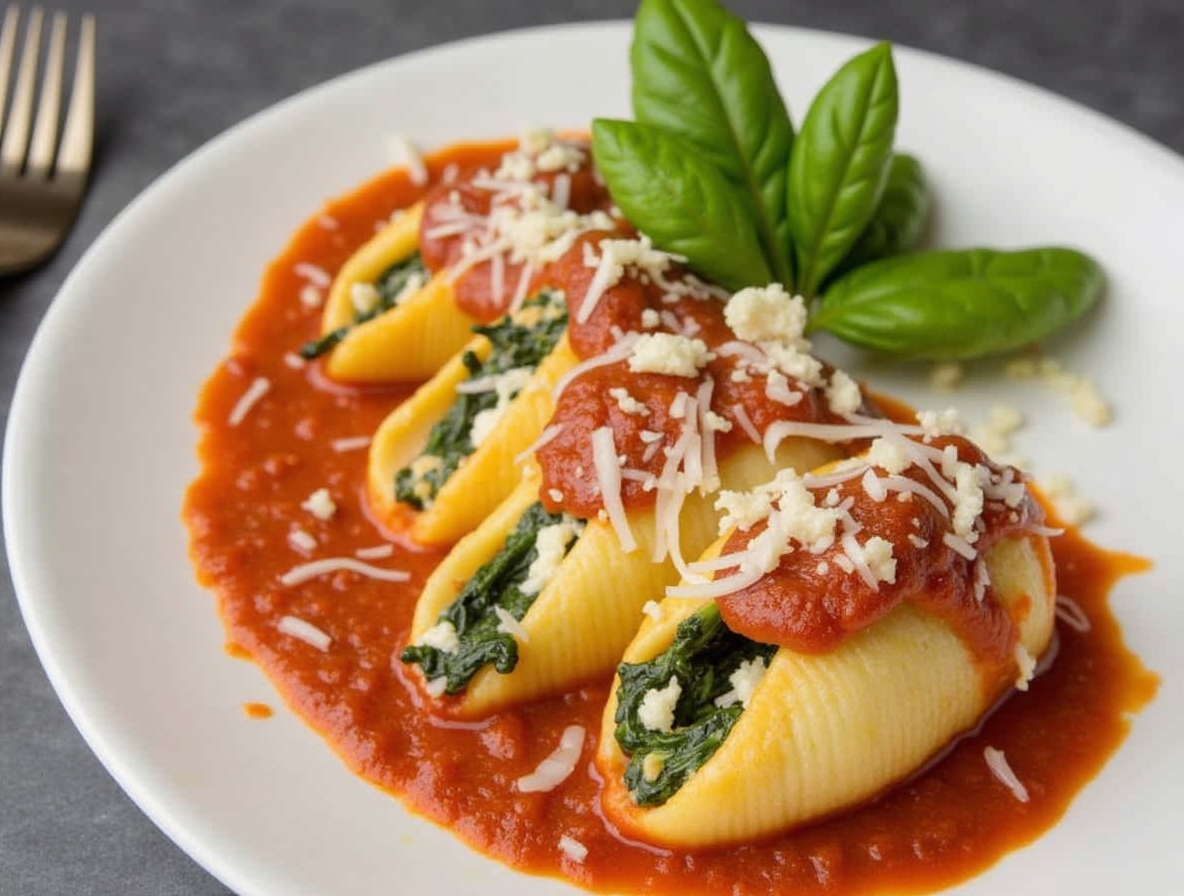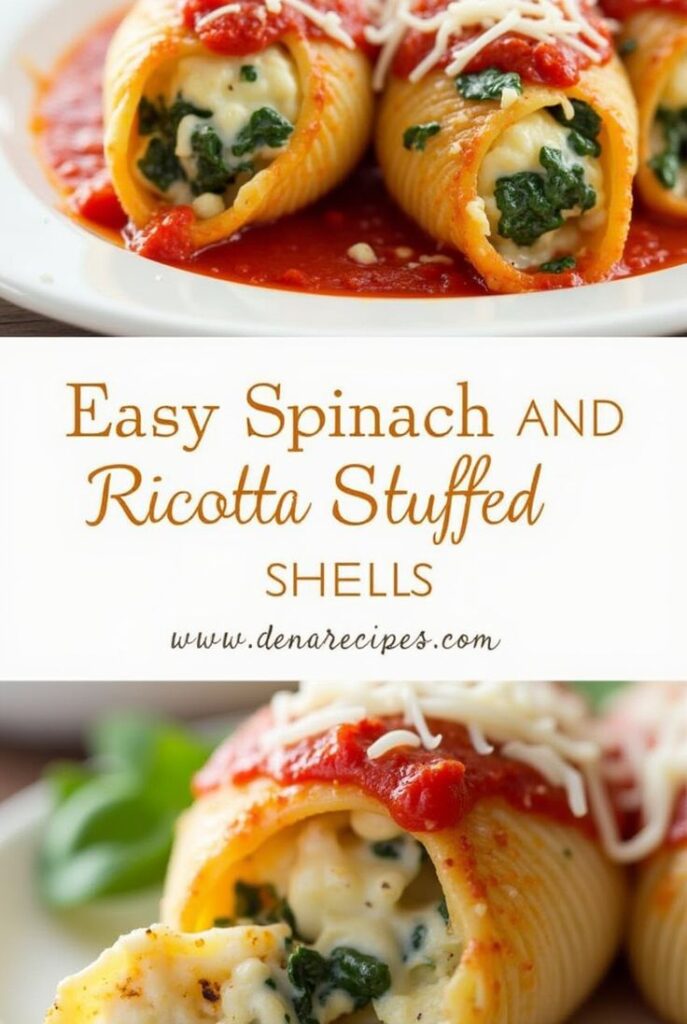Restaurant-Worthy Stuffed Pasta Shells Recipe (Ready in 30 Minutes)
Stuffed pasta shells recipe featuring a magnificent trio of cheeses—ricotta, mozzarella, and Parmesan—creates a dish that rivals your favorite Italian restaurant. I’ve perfected this comfort food classic that not only satisfies the whole family but also comes together in just 30 minutes. Best of all, this recipe eliminates the need to pre-cook the shells, as they bake directly in a generous amount of sauce.
These jumbo pasta shells, also known as conchiglioni, have become increasingly available in grocery stores, making stuffed pasta recipes more accessible than ever. Additionally, our spinach and ricotta stuffed pasta shells recipe serves 5-6 people, delivering approximately 798 calories and 43g of protein per serving. We love that this stuffed jumbo pasta shells recipe can be prepared up to two days in advance, perfect for busy weeknights or weekend gatherings. Furthermore, the versatility of this dish allows for numerous variations—whether you prefer adding meat or experimenting with different cheeses to match your dietary preferences.
Key Ingredients for Perfect Stuffed Pasta Shells
The perfect stuffed pasta shells start with selecting the right ingredients. Creating a restaurant-quality dish depends on understanding each component and how they work together.
Jumbo pasta shells and why they matter
Jumbo shells (conchiglioni in Italian) form the foundation of this dish. A standard 12-ounce package contains approximately 33-35 shells. However, since some inevitably break during cooking, I recommend boiling the entire box even though you’ll only fill about 28 shells. For optimal texture, cook them 2-3 minutes less than package directions indicate. This undercooking is crucial because the shells continue baking in the sauce, preventing them from becoming mushy.
Choosing the right ricotta and mozzarella
Quality cheese makes all the difference in stuffed shells. When selecting ricotta, avoid brands containing gums like carageenan or xanthan gum. Instead, look for varieties listing only milk, salt, and bacterial starter. Moreover, draining excess moisture from ricotta prevents a watery filling—simply spread it on paper towels for about five minutes before mixing.
For mozzarella, skip pre-shredded options which contain anti-caking agents that prevent smooth melting. Whole milk varieties deliver superior creaminess, though part-skim works for lighter versions. Freshly grated parmesan or pecorino romano adds depth to the filling.
Fresh vs frozen spinach: what to use
Both fresh and frozen spinach work wonderfully in stuffed shells. If using fresh, you’ll need about 10 ounces (approximately 10 cups) of baby spinach. Conversely, for frozen spinach, a 10-ounce package suffices.
Frozen spinach offers convenience and value, especially during winter months. Plus, it comes from mature spinach plants which often provide better flavor than baby varieties. Regardless of which type you choose, removing excess moisture is essential—squeeze thawed frozen spinach in a clean kitchen towel or spin fresh sautéed greens in a salad spinner.
Optional add-ins: nutmeg, herbs, and more
A pinch of freshly grated nutmeg elevates the spinach-ricotta filling with subtle warmth. Meanwhile, fresh herbs like basil, parsley, oregano, thyme, and rosemary add brightness.
Beyond herbs, consider incorporating lemon zest and red pepper flakes for brightness and gentle heat. Minced garlic is practically non-negotiable for authentic flavor. For protein variations, ground beef or Italian sausage blend beautifully with the cheese mixture.
Those seeking alternatives might substitute cottage cheese for some or all of the ricotta. Similarly, different greens like kale or arugula can replace spinach for unique flavor profiles.
Step-by-Step Guide to Making Stuffed Shells
Creating restaurant-worthy stuffed pasta shells at home is easier than you might think. Following this simple step-by-step process ensures perfect results every time.
1. Boil the pasta shells until al dente
Fill a large pot with heavily salted water and bring it to a rolling boil. Add the jumbo pasta shells and cook them for 8-10 minutes or until they’re just shy of al dente. Stir occasionally to prevent the shells from sticking together at the bottom. Once cooked, drain the shells and rinse immediately with cold water to stop the cooking process. This cooling step is crucial as it makes the shells easier to handle when stuffing. Spread the cooled shells on a parchment-lined tray to prevent them from sticking together.
2. Sauté garlic and spinach for the filling
Heat olive oil in a skillet over medium-high heat. Add minced garlic and cook until barely golden, about 30 seconds to 1 minute. Subsequently, add the spinach with a pinch of salt and cook until wilted, approximately 3-4 minutes. The spinach should reduce by about half during this process. Once wilted, transfer the spinach mixture to a plate or bowl and allow it to cool slightly. For extra flavor, you might consider adding herbs like oregano and basil while sautéing.
3. Mix cheeses, egg, and spinach together
In a large bowl, beat one egg. Add ricotta cheese (about 2 heaping cups), 2 cups of shredded mozzarella, and 1/4 cup Parmesan or Pecorino Romano. Mix these ingredients thoroughly. Afterward, fold in the cooled spinach mixture, plus salt and pepper to taste. The filling should be well combined but still maintain some texture. For the best flavor, taste and adjust seasonings as needed, remembering that the overall saltiness will depend on the cheeses used.
4. Stuff the shells and layer with sauce
Spread about 1 cup of marinara sauce evenly on the bottom of a 9×13-inch baking dish. Fill each shell with approximately 1-2 tablespoons of the cheese mixture. You can use either a small spoon or transfer the filling to a piping bag with a wide tip for easier handling. Place the filled shells in the prepared baking dish with the opening facing upward. Once all shells are arranged, pour the remaining sauce over them, ensuring they’re well covered.
5. Bake until bubbly and golden
Sprinkle the remaining cup of mozzarella cheese over the sauced shells. Cover the dish with aluminum foil and bake at 375°F for about 30 minutes. Afterward, remove the foil and continue baking for another 5-10 minutes until the cheese is fully melted and beginning to brown. For an extra golden top, briefly place under the broiler for 1-2 minutes. Allow the dish to rest for a few minutes before serving to let the flavors meld together.
Tips to Make It Restaurant-Worthy
Elevating homemade stuffed shells from good to restaurant-quality requires attention to a few critical finishing touches. These professional techniques will transform your pasta creation into a dish worthy of your favorite Italian eatery.
Use fresh herbs for garnish
Fresh herbs make an immediate visual and flavor impact on your stuffed pasta shells recipe. I highly recommend using fresh basil, parsley, or oregano rather than dried varieties whenever possible. These vibrant herbs not only add bright color contrast against the golden cheese but infuse your dish with aromatic complexity. In fact, some chefs use up to two whole bunches of herbs to keep everything light and fresh despite the richness of the cheese. Sprinkle them just before serving, as heat diminishes their delicate flavors and visual appeal.
Don’t skip the broil for a golden top
The hallmark of restaurant-quality stuffed shells is that perfectly browned, bubbly cheese surface. After baking covered for about 30 minutes, uncover the dish and broil for 2-3 minutes until the cheese becomes golden and bubbly. This critical step creates that distinctive caramelized finish that signals a professionally prepared dish. For even better results, tear fresh mozzarella into small pieces and dot over the shells before broiling.
How to avoid soggy or dry shells
Primarily, prevent watery stuffed pasta by selecting ricotta without added gums, which release excess moisture during baking. Next, cook shells precisely to al dente—about one minute shy of package directions—as overcooked pasta releases starch that combines with sauce to create unwanted moisture. Additionally, let your finished dish rest for 5-10 minutes before serving, as this allows excess moisture to be reabsorbed. Conversely, to prevent dryness, ensure shells are completely covered with sauce during baking.
Make-ahead and freezing tips
Stuffed shells excel as a make-ahead meal. You can:
- Refrigerate assembled (unbaked) shells for up to 3 days
- Freeze unbaked shells for up to 3 months
- For freezing, wrap tightly in plastic wrap followed by foil
- When ready to bake from frozen, remove plastic wrap but keep foil cover
- Bake frozen shells at 350°F for approximately 90 minutes covered, plus 15-30 minutes uncovered
This flexibility makes stuffed jumbo pasta shells ideal for busy weeknights or advance party preparation.
Variations to Try for Every Taste
Once you’ve mastered the classic stuffed pasta shells recipe, why not explore these delicious variations that can transform your basic dish into something extraordinary? The beauty of this versatile pasta lies in how easily it adapts to different tastes and dietary needs.
Add ground beef or sausage for a meaty version
For protein lovers, incorporating meat elevates stuffed shells to a heartier meal. Sweet Italian sausage is particularly recommended for its distinctive flavor profile that complements the cheese beautifully. Alternatively, you can use a combination of ground beef and sweet Italian sausage for a more complex taste. Ground turkey makes an excellent substitute if you’re looking for a leaner option. Simply brown your chosen meat before mixing it with the ricotta filling. For those who prefer to keep it vegetarian, feel free to omit the meat entirely without compromising on taste.
Use Alfredo or vodka sauce instead of marinara
Swapping traditional marinara for a creamy vodka sauce creates a luxurious twist on stuffed pasta shells. The richness of vodka sauce pairs wonderfully with smoked mozzarella, adding a subtle woodsy flavor to the dish. Alfredo sauce offers another creamy alternative that works particularly well with peas or asparagus mixed into the filling. For those concerned about alcohol, you can create an alcohol-free version using water mixed with a squeeze of lemon juice or white wine vinegar to maintain that essential acidity.
Make it gluten-free with alternative pasta shells
Thankfully, gluten-free jumbo shells are increasingly available, making this classic accessible to those with celiac disease or gluten intolerance. Brands like Barilla and Tinkyada offer reliable gluten-free options that maintain their structure during cooking. Remember that gluten-free pasta can be more delicate, so handle with extra care when stuffing. If you can’t find gluten-free shells, consider using gluten-free cannelloni or manicotti as alternatives, or layer the filling between gluten-free lasagna sheets.
Try kale or arugula instead of spinach
Leafy greens add nutrition and flavor to stuffed shells. Kale makes an excellent spinach substitute, offering a slightly more robust texture and earthy flavor. The preparation remains essentially the same: simply wilt the kale before incorporating it into your ricotta mixture. For those who enjoy more pronounced flavors, arugula adds a peppery kick that contrasts nicely with the creamy cheese filling. Feel free to adjust the ratio of greens to ricotta based on your preference—more greens create a filling with brighter color and stronger vegetable flavor.
Conclusion
Stuffed pasta shells undoubtedly deserve a place in your dinner rotation. This 30-minute recipe transforms simple ingredients into a dish that rivals any Italian restaurant offering. The magnificent trio of cheeses creates that perfect balance of creaminess and flavor, while the no-pre-cook method makes preparation surprisingly straightforward.
After trying this recipe, you’ll likely find yourself making it again and again. Most importantly, the versatility allows endless adaptations to suit your family’s preferences—whether adding protein, switching sauces, or experimenting with different greens. The make-ahead capability certainly adds to its appeal for busy households.
Previously, you might have thought restaurant-quality Italian food required hours in the kitchen. Now, armed with these techniques and tips, you can create impressive stuffed shells with minimal effort. Consequently, weeknight dinners become special occasions without the associated stress.
Lastly, don’t forget those finishing touches that elevate home cooking to restaurant status—fresh herbs, that perfectly broiled golden top, and the right sauce-to-pasta ratio. These details, though small, make all the difference between good and exceptional stuffed shells.
The next time you crave Italian comfort food, skip the takeout menu and reach for jumbo pasta shells instead. Your family will thank you, and you’ll enjoy the satisfaction of creating something truly special in your own kitchen.
FAQs
Q1. Can I prepare stuffed shells in advance? Yes, you can prepare stuffed shells ahead of time. Assemble the dish and refrigerate it for up to 3 days before baking. When ready to cook, bring it to room temperature and add the final layer of sauce and cheese just before baking.
Q2. What ingredients are typically mixed with ricotta for the stuffed shells filling? The classic filling for stuffed shells includes ricotta cheese, eggs, salt, pepper, and parsley. This mixture is often combined with grated Parmesan and mozzarella cheeses for added flavor and texture.
Q3. Why are eggs added to the stuffed shells filling? Eggs are added to the filling to help bind the ingredients together. They make the filling easier to pipe into the shells and help it stay in place during baking, resulting in a better texture and consistency.
Q4. Can I substitute ricotta cheese in stuffed shells? Yes, you can substitute ricotta cheese in stuffed shells. Cottage cheese is a popular alternative that adds protein and works well even for those who aren’t typically fans of cottage cheese. For best results, use 4% milkfat cottage cheese.
Q5. How can I make my homemade stuffed shells taste restaurant-quality? To achieve restaurant-quality stuffed shells, use fresh herbs for garnish, broil the dish briefly for a golden top, ensure the shells are neither soggy nor dry by cooking them al dente, and let the dish rest before serving. These small touches can elevate your homemade stuffed shells to rival those from your favorite Italian restaurant.


